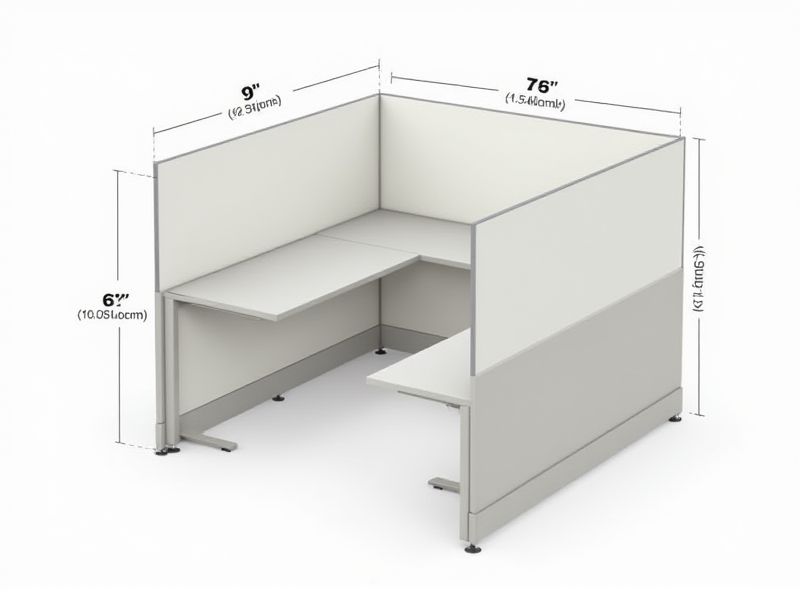
Standard office cubicle dimensions can vary, but most commonly measure around 6 feet by 6 feet (1.8m x 1.8m) or 8 feet by 8 feet (2.4m x 2.4m). These sizes offer enough space for a desk, chair, and some storage, allowing employees to work comfortably without feeling cramped. Smaller cubicles might measure as little as 5 feet by 5 feet (1.5m x 1.5m) in high-density offices, while larger executive cubicles can reach up to 12 feet by 12 feet (3.6m x 3.6m). When planning an office, it's important to consider both the available floor space and the specific work needs of your team to choose the right cubicle size.
Width
The standard width for office cubicles typically ranges from 4 to 6 feet, providing adequate personal space for employees. A well-designed cubicle promotes productivity by minimizing distractions while fostering a sense of privacy. Many organizations opt for modular designs, allowing customizable layouts that can accommodate various team sizes. Investing in ergonomic furniture within this space can enhance comfort, potentially leading to higher employee satisfaction and reduced turnover rates.
Depth
The standard depth of an office cubicle typically ranges from 5 to 6 feet, providing ample space for a desk, chair, and essential office equipment. A depth of 6 feet is optimal, promoting a comfortable work environment and reducing distractions. Ergonomics play a key role, as adequate depth allows for better posture and airflow, enhancing overall productivity. By ensuring that your cubicle meets these depth standards, you can create a more efficient and functional workspace that caters to your needs.
Height
The standard height for office cubicles typically ranges from 54 to 66 inches, depending on design and privacy needs. This height allows for adequate separation between workstations while maintaining an open feel within the workspace. In environments requiring more collaborative interaction, designers often choose cubicles on the lower end of this spectrum. Ensuring the cubicle height aligns with ergonomic standards can enhance comfort and productivity in your workspace.
Partition Thickness
The standard partition thickness for office cubicles typically ranges from 2 to 4 inches, providing optimal sound insulation and privacy. Thicker partitions, around 4 inches, can reduce noise levels significantly, enhancing concentration and productivity in the workplace. Many organizations choose modular systems that allow for customization, accommodating different needs while maintaining aesthetic appeal. When planning your office layout, consider the balance between partition thickness and open space to foster collaboration while also ensuring individual focus.
Work Surface Size
The standard work surface size for an office cubicle typically measures 60 inches in width and 30 inches in depth, providing ample space for your computer, documents, and other essential office supplies. This workspace design allows for efficient use of the 10 to 12 square feet allotted per cubicle, promoting productivity while ensuring comfort. Furthermore, ergonomic considerations often feature a height of 29 to 30 inches, aligning with the average sitting position for users. By optimizing the work surface area, companies can create an environment that supports both individual workflow and collaborative efforts.
Storage Space
The standard office cubicle typically provides an average storage space of around 15 to 25 cubic feet, accommodating essential office supplies and personal items. Most cubicles feature a combination of shelves, drawers, and filing cabinets, ensuring organized storage solutions tailored for efficiency. In modern designs, the integration of vertical storage helps to maximize floor space, allowing you to maintain a clutter-free workspace. Leveraging these storage options can enhance productivity and create a more comfortable work environment.
Electrical Outlets
The standard office cubicle typically features 2 to 4 electrical outlets strategically placed to accommodate various electronic devices. With an average workspace size of 6 feet by 8 feet, these outlets allow for convenient access to power for laptops, monitors, and chargers. Many designs integrate cable management systems to reduce clutter, ensuring a tidy work environment. When planning your office setup, consider the placement of these outlets to enhance productivity and comfort.
Lighting Arrangement
Effective lighting arrangement in office cubicles significantly enhances employee productivity and comfort. Studies indicate that natural light improves worker morale and reduces eye strain, promoting a healthier work environment. It is recommended to have at least 300-500 lux of light intensity for optimal task performance in office spaces. Incorporating adjustable LED fixtures can also allow you to personalize your lighting preferences, fostering a more efficient workspace.
Acoustic Properties
Office cubicles are increasingly designed with a focus on acoustic properties to enhance workplace productivity. Sound-absorbing materials, such as acoustic panels and carpets, can reduce noise levels by up to 50%, minimizing distractions in open-office environments. The average noise level in a traditional office can reach 65 decibels, but optimized cubicle designs aim to maintain levels below 55 decibels, promoting better concentration. You can expect these improvements to not only offer a more tranquil work atmosphere but also to contribute to overall employee satisfaction and well-being.
Personalization Options
Modern office cubicle design emphasizes personalization options to enhance employee satisfaction and productivity. A survey by the Global Workspace Association found that 67% of employees feel more engaged when they can personalize their workspace. Features like adjustable desk heights, movable dividers, and customizable decor create an atmosphere tailored to individual preferences. Implementing these changes can lead to a 24% increase in overall employee performance, making a compelling case for the integration of personalization in cubicle design.
